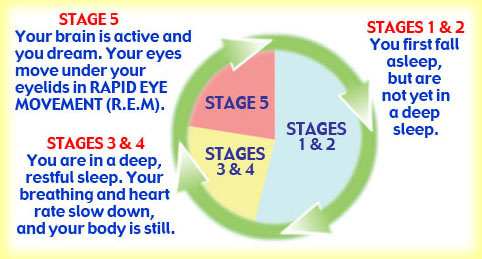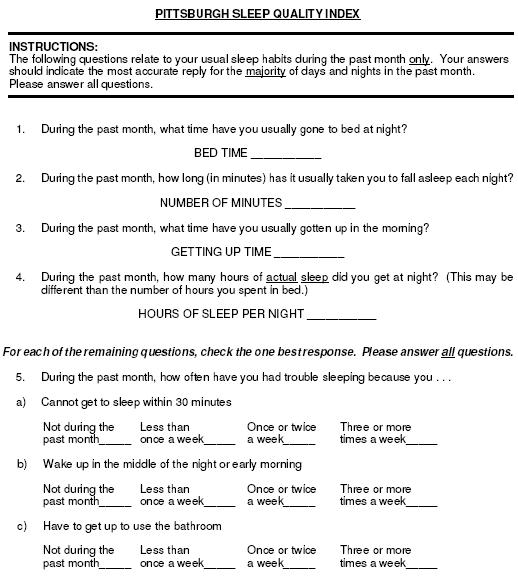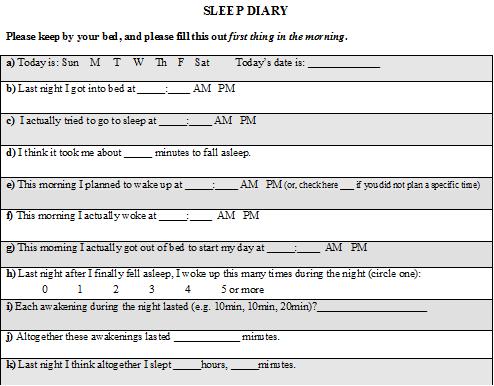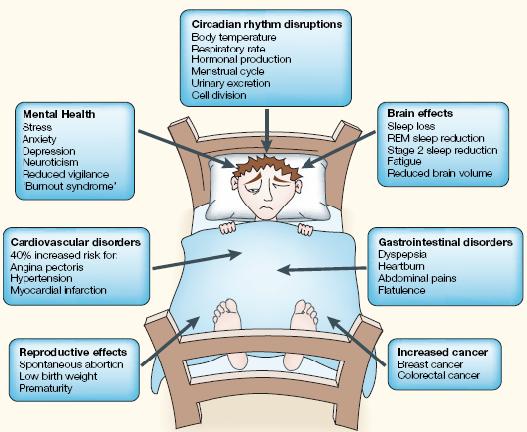













What is Sleep?
There are many different ways to define sleep. One way to define sleep is a behavioral state in which a person is completely disengaged from the environment. A person is not able to respond to the environment while in this reversible state. Another way to define sleep is your body’s way of resting. Sleep is different than being awake because we do not respond to things while sleeping. It is not until something wakes us up that we are able to respond to our environment. Sleep allows our body to reenergize and refresh for the following wake period.
What is a Sleep Cycle?
During sleep most people (excluding those with certain sleep disorders) cycle through Rapid Eye Movement (REM) sleep and four stages of Non-Rapid Eye Movement (nREM) sleep each night. REM sleep (aka: dream sleep) is identified when a person has rapid eye movements and zero muscle activity and nREM sleep is identified when a person has no eye movements and some muscle activity (muscle jerks, etc.). One complete nREM-REM cycle lasts between ninety and one-hundred-twenty minutes.
Immediately following sleep onset (when you fall asleep) nREM sleep occurs starting with stage one. Stage one of the nREM sleep cycle lasts for approximately one to seven minutes. During this period it is very easy for a person to be disturbed. Stage one makes up about 2-5% of a night’s sleep. Stage two sleep lasts approximately ten to twenty-five minutes. A person is not as easily disturbed in this stage as they are in stage one. Stage two accounts for about 45-55% of the night
Stages three and four are known as “slow wave sleep” (SWS). They are the deepest stages of the four nREM stages. Stage three lasts only a few minutes because it is a transitional stage preparing for stage four. 3-8% of sleep consists of stage three sleep. Stage four sleep lasts for about twenty to forty minutes and accounts for about 10-15% of the night.

REM sleep in the first cycle of sleep is usually short lasting about one to five minutes. Duration of REM sleep lengthens throughout the night. REM sleep accounts for about 20-25% of sleep, while nREM sleep accounts for the remaining 75-80%.
How is Sleep Measured?
There are two types of sleep measures, subjective and objective tests. A couple examples of subjective tests include observations and self-report surveys. Observation involves watching a person sleep. Signs of sleep include laid back body position, lack of movement, slow and regular breathing, a blank facial expression, and closed eyes. There are many types of surveys. One type is a survey in which the person reports past sleeping patterns. An example of this is the Pittsburgh Sleep Quality Index (PSQI) which examines the last 30 days. The PSQI consists of multiple choice questions involving frequency of disturbances in sleep, sleep quality, typical bedtime, wake time, amount of time it takes to fall asleep and total sleep time. Another type of survey involves reporting results of the previous night’s sleep. An example of this is a sleep diary. Below is an example of the types of questions asked every morning following a night of sleep.


Objective tests include methods such as actigraphy and polysomnography. Actigraphy uses a wrist watch like instrument to measure an approximate determination of a person’s sleep/wake cycle through movement over a night’s sleep. Inside the wrist watch is a sensor which converts the amount of movements and their durations into numerical data which can be analyzed by a sleep specialist. Polysomnography (PSG) measures many different things. During PSG electrodes are placed on an individual’s head and face in order to measure the electrical currents running through the body. It records brain activity through EEG (electroencephalogram), muscle activity through EMG (electromyogram), and eye movement through EOG (electrooculogram). Each of these measurements allows us to observe a person’s sleep cycle and also can be helpful in diagnosing sleep disorders.



How Many Hours of Sleep is Considered Healthy?
Every person is different. The average rule of thumb regarding the amount of sleep an individual should get is between 7 1/2 and 8 1/2 hours. It is normal to be tired immediately after waking up. This sleepiness or grogginess is called sleep inertia and is very common.
What Are Examples of Sleep Disorders? How Are They Treated?
Insomnia is one of the most commonly known sleep disorders. Insomniacs have difficulty falling asleep and/or staying asleep, they wake up earlier than planned, and they do not have restorative sleep. These symptoms occur three or more nights per week for at least one month. These symptoms are not due to another mental disorder, sleep disorder, or effects of chemical substances. Many people tend to use over the counter drugs such as Excedrin PM in attempts to manage their disorder. Also, alcohol has been known to be used in those who are having problems managing their disorder.
Narcolepsy is a REM sleep disorder. Narcoleptics have excessive daytime sleepiness (EDS) which triggers sudden sleep attacks. These sleep attacks occur every day for at least three months. Similar to insomnia, some narcoleptics have difficulty falling and staying asleep. Medications such as suprachiasmatic nucleus (SCN) stimulants and modifications to daily activities (such as exercising, light exposure, avoidance of alcohol and napping,etc.) have been used to treat this disorder.
Sleep apnea is another sleep disorder. Sleep apnea does not have a concrete definition. However, it is thought to be a sleep disorder that results in upper airway constriction which has detrimental effects on sleep. Usually sleep apnea involves loud snoring and periods where an individual stops breathing. CPAP aka: Continuous Positive Airway Pressure machine is one of the most common treatments for sleep apnea. A CPAP machine blows air through a hose which is connected to a nasal mask. The individual wears the mask and the air blows through the nose and/or mouth in order to force open the upper airway.
What Happens If I Do Not Get Enough Sleep?
Lack of sleep can lead to decreased immune function. Healthy adults who slept a total of less than seven hours per night were three time more likely to get sick than those who slept eight hours. Sleep deprivation is also correlated with mental health disorders (such as stress, anxiety, depression, etc), gastrointestinal disorders (heartburn, abdominal pains, etc.), increased risk for breast and colorectal cancer, etc.

Do Animals Sleep?
No, not all species sleep. First, sleep must be distinguished from other sleep-like states such as hibernation and torpor. Hibernation is a very deep ‘sleep’ that lasts for periods of days, weeks, or months. Torpor is a state of inactivity similar to hibernation that lasts over shorter periods of times. It is even true that some species never sleep. Simple organisms are one example of a species in which there is no evidence of sleep. Amphibians are another species that do not sleep. Birds and land mammals are two types of species that do sleep.
Does Alcohol affect Sleep?
With short-term use it appears that alcohol makes you sleep better. This is because you might fall asleep faster and slow wave sleep (stages 3 and 4: "deep sleep") increases while REM decreases. In the latter part of the night REM sleep increases in order to make up for the original deficiency. However, long-term users reported poor sleep quality when asked to complete a questionnaire involving sleep quality after alcohol use. Long-term alcohol use and insomnia may also be correlated.
Will I Sleep Better if I Exercise?
Exercise can be helpful for good sleep when done in the morning or afternoon. However, if it is done too close to bedtime (ex: 3 hrs) it can have the opposite effect. People become alert when they exercise and body temperature rises. Five to six hours after exercise is the ideal time to go to bed because that is when body temperature drops making it easier to fall asleep. Studies have been done on the elderly that indicated that sleep quality and total sleep time improved. Also, the amount of time needed to fall asleep decreased.
Is Sleep affected by Stress?
There does seem to be a correlation between stress and sleep. Stress seems to make falling asleep and staying asleep harder. As a result most people (especially college students) tend to complain of poor sleep quality.
How Does Caffeine affect My sleep?
Caffeine can affect the amount of time it takes to fall asleep depending on the amount taken and the time it is ingested. A person’s tolerance to the stimulant also plays a role in whether sleep is affected. Caffeine binds to receptors in the brain and prevents sleep-inducing and mood-depressing chemicals from being released therefore caffeine can increase the amount of time it takes for a person to fall asleep
Why Do I get Cold when I Sleep?
In order for your body to conserve energy while you sleep it slightly lowers your core body temperature. This is probably why we tend to sleep better in cooler conditions and have a hard time sleeping in high temperatures. Heart rate also decreases in order to conserve energy.
Carskadon, M. A. and W. C. Dement (2005). Normal human sleep: An overview. In M. H. Kryger, T. Roth & W. C. Dement (Eds.), Principles and practice of sleep medicine. 4th Edition (13-23). Philadelphia: Elsevier.
Foster, R. G., & Wulff, K. (2005). The rhythm of rest and exercise. Nature Reviews Neuroscience, 6:407-414.
Hamilton, N., Nelson, C., Stevens, N., & Kitzman, H. (2007). Sleep and psychological well-being. Social Indicators Research, 82(1), 147-163
Lund, H., Reider, B., Whiting, A., & Prichard, J. (2009). Sleep patterns and predictors of disturbed sleep in a large population of college students. Journal of Adolescent Health
Montgomery, P., & Dennis, J. (2002). Physical exercise for sleep problems in adults aged 60+. Cochrane Database Syst Rev. 2002;4.
Murray, G., Nicholas, C., Kleiman, J., Dwyer, R., Carrington, M., Allen, N., et al. (2009). Nature’s clocks and human mood: The circadian system modulates reward motivation. Emotion, 9(5), 705-716.
Ohayon, M. (2008). From wakefulness to excessive sleepiness: What we know and still need to know. Sleep Medicine Reviews, 12:129-141.
Roth, T. (2007). Insomnia: Definition, prevalence, etiology and consequences. Journal of Clinical Sleep Medicine, S3(5):S7-S10.
Siegel, J. M. (2008). Do all animals sleep? Trends in Neuroscience, 31:208-213.
Smith, L. J., S. Nowakowski, et al. (2003). The measurement of sleep. In M. L. Perlis and K. L. Lichstein (Eds.), Treating sleep disorders: Principles and practice of behavioral sleep medicine (29-73). New York, NY: John Wiley & Sons, Inc.
Spencer, R. (2000). Psychology of Sleep [PowerPoint slides]. Retrieved from https://spark.oit.umass.edu
Stradling, J. R. & Davies, R. J. (2004). Obstructive sleep apnea/hypopnea syndrome: definitions, epidemiology, and natural history. Thorax, 59:73-78.
Vail-Smith, K., Michael Felts, W., & Becker, C. (2009). Relationship between sleep quality and health risk behaviors in undergraduate college students. College Student Journal, 43(3), 924-930.
Michelle Dube, Psychology of Sleep (Fall 2009)